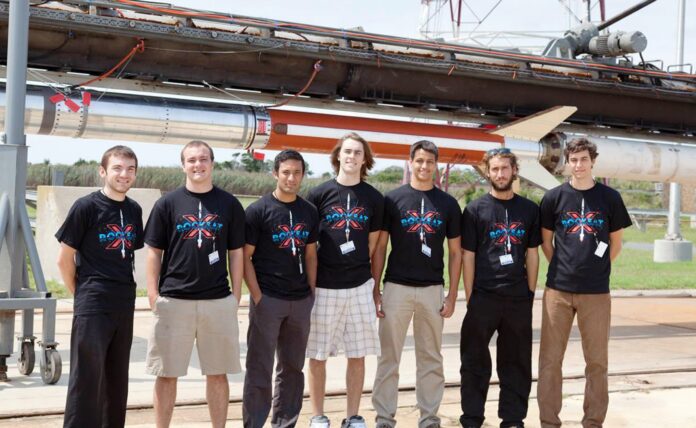
Virginia Tech College of Engineering students watched their experiments blast into space last Friday aboard a rocket that launched from NASA’s Wallops Flight Facility. The spacecraft climbed roughly 99 miles or 160 kilometers into the thermosphere before diving back to Earth for an Atlantic Ocean splash landing via parachute.
The NASA-owned, two-stage, 40-foot long Terrier-Improved Malemute rocket carrieda series of experiments created by students from Virginia Tech’s Department of Aerospace and Ocean Engineering as well as student teams from three other U.S. universities: Baylor University, University of Colorado at Boulder, the University of Puerto Rico. The full flight time was right at 15 minutes, according to a NASA Wallops website.
“Launches at NASA Wallops are a sight to see,” said Stephen Noel of Christiansburg and a first-year master’s student in aerospace engineering who also is serving as team leader of the project. Noel recently finished an internship at Wallows Flight Facility and was witness to several previous rocket launches.
“The speed and power of the sounding rockets are even more impressive in person,” said Noel, who is pursuing a master’s in dynamics and control. “A launch is even more significant and exciting when you have a piece of hardware or an experiment flying onboard. At NASA Wallops, they allow the students or employees fairly close to the launch pad, although outside the danger zone of the rocket. At that distance there is a significant time delay between seeing and hearing ignition, which is interesting.”
Last Friday’s launch is part of NASA’s RockSat program, an educational project designed to provide students with hands-on experience in designing, fabricating, testing, and conducting experiments for space flight. The RockSat-X team was tasked with designing a payload and power system to support several experimental projects, including an optical nitric oxide sensor and an aperture vacuum seal release mechanism for the Space Barometer CubeSat or a miniature box-like satellite instrument, both built by Hokie students. The payload also will test two inertial measurement units for future CubeSat use.
Virginia Tech’s nitric oxide sensor will have an un-obscured field view of the Earth’s upper atmosphere, and will use an optical bandpass filter which passes only light in a small band, around 220 nanometers, and a custom-designed sensor housing built by students. Serving as faculty adviser on this experiment is Scott Bailey, associate professor with the Bradley Department of Electrical and Computer Engineering and a member of Virginia Tech’s Center for Space Science and Engineering Research program.
Design of the payload for the rocket by student teams requires strict adherence to NASA guidelines, in addition to communication and cooperation with the principal investigators of each experiment, Noel said. This included numerous readiness reviews along the way, presented by students to Colorado Space Grant Consortium and reviewed by NASA engineers.
“Each of these payloads performs separate experiments for each university, and the payloads operate independently of each other,” he added. “NASA provides each payload with power and a connection to the transmitter on the rocket which communicates each payload’s data with NASA’s ground station.”
The Sept. 21 launch was actually the third attempt to launch the RockSat-X rocket. Two previous tries in August were scrubbed because of too many boats in nearby waters of the Atlantic Ocean for a major fishing tournament, and then foul weather.


